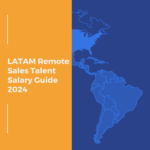The law and business are deeply intertwined, if the way we work changes, the law will follow swiftly behind with policy considerations to compensate for the adjustment and protect the interest of the workers involved.
The law reshapes itself to reflect the evolving contours of the business world. As remote work emerges as a dominant force, legal frameworks are rapidly morphing to address its unique challenges and opportunities.
What do you need to know about the legal side of hiring remotely?

Understanding the legal rules for remote hiring is complex, as they differ from one region to another, including federal, state, and international regulations. It’s often like trying to decode a complex language.
This guide covers the details you need to know for remote hiring, including written employment contracts, international agreements, intellectual property, data privacy, and more.
For remote work law compliance, remember this simple tip:
Your business should abide by the laws of the area where your employee lives, not where your main office is located.
To ensure legal compliance and develop a remote hiring plan, consider the following legal aspects of remote work:
Utilizing a third-party Employer of Record Service

Employment laws for remote workers become very complex when hiring across various states, provinces, and countries.
Instead of employing a group of lawyers, accountants, and payroll experts familiar with both domestic and international remote work rules, an EOR takes care of these global employment law requirements for you.
They serve as a protective layer between your company and potential remote work issues, such as tax mistakes and compliance problems. This way, you don’t need to be a specialist in global remote hiring laws to find and hire the best team members.
For a set monthly cost, an EOR makes sure your company accurately:
Identifies workers as employees or contractors.
Follows local laws for state minimum wage and how often employees get paid.
Pays hourly and salaried employees in their currency.
Adheres to specific tax regulations of each location.
Offers appropriate health and medical insurance, benefits, vacation days, sick leave, and other time off according to local rules.
Complies with local laws for ending employment, notice periods, and severance pay.
Ensuring compliance with workplace safety and discrimination laws
Handling employment documentation and record-keeping
Key Figures from Business Research Insights Annual Report (Forcast)
Utilizing a third-party Employer of Record (EOR) service can significantly streamline the complexities of complying with remote worker employment laws across different jurisdictions. The global market size for EOR services was valued at $128.2 million in 2021 and is projected to reach $196 million by 2028, growing at a CAGR of 6.8%.
EORs handle all formal employment-related processes, allowing firms to operate with international employees without establishing a local corporation or risking non-compliance with local labor laws.
The rise of cloud-based technologies, high-bandwidth internet, and social networking are key drivers of this market.
The COVID-19 pandemic initially impacted the job screening market negatively but eventually led to a surge in remote work and the need for effective employment screening, making EOR services more vital.
The efficacy and efficiency of EORs compared to conventional hiring approaches are also contributing to market expansion
Classifying Remote Workers
When hiring remotely across various sectors, teams often deal with both full-time employees and freelancers. Correctly classifying these workers is crucial for following employment laws and tax rules.
With the rise of gig economy jobs, authorities are scrutinizing worker categories more closely. Getting this wrong can result in harsh penalties, expensive fines, repayment of benefits and tax purposes, and other stressful outcomes.
Canada and the US, follow the same rules for classifying remote workers are alike. The key distinctions between a remote employee and a remote freelancer or contractor include:
Autonomy. Workers who are directed by employers in terms of where, how, and when to work are employees. Contractors, on the other hand, work independently, use their tools, and can offer their services to various companies.
Benefits. Contractors don’t get the same employment benefits as employees, like paid leave, job security, overtime pay, and other advantages.
Taxes. Freelancers handle their own tax payments, social security, healthcare contributions, and similar responsibilities.
The European Union has distinct employment laws, but each member country decides how to classify workers, with each having unique rules. The UK, for instance, has various worker categories, rights for part-time remote workers, and protections for independent contractors.
In Asia-Pacific nations, classification standards differ greatly. In China, for example, anyone who adheres to a company’s rules can be considered an employee.
In most Latin American countries, regardless of whether someone is a full-time, part-time, or contract worker, they are entitled to the same employment benefits.
Feeling overwhelmed? That’s understandable.
That’s why it’s a good idea to get advice from experts in employment law for the specific area you’re hiring from. This is the most straightforward method to make sure you’re following local labor laws and employee classification regulations.
Terms of Remote Employment Contracts

After classifying your new remote worker, deciding their contract terms becomes much simpler.
Full-time or Open-ended contracts are typically used for full-time employees. These contracts continue until either side chooses to end it.
Part-time contracts suit roles that don’t need a full-time commitment. You should check the local labor laws to understand the rights and restrictions for part-time workers, including work hours, overtime, benefits, etc.
Fixed-term contracts are set for a certain duration and are often used for freelancers or contractors. They’re ideal for project-based remote work, filling temporary skill gaps, or substituting for full-time employees on leave.
Remote Work Employment Agreements

These agreements clarify everyone’s roles and responsibilities. They set out what’s expected and ensure adherence to all relevant judicial, regulatory, and policy requirements. They’re vital for fostering trust and openness, which enhances the remote work environment.
Remember, it’s crucial to follow the local and federal laws where your employee is based, an
d in some cases. For example, the EU demands detailed contracts for remote workers, while the rules in other countries might be more flexible.
Generally, these contracts are drafted in the official language of your remote employee’s country and need to be signed by both you and the employee.
Employee Working Hours and Overtime Compensation

In the United States, salaried employees don’t receive overtime pay, no matter how many hours they work. On the other hand, hourly employees are entitled to 1.5 times their regular pay for every hour they work beyond 40 hours a week.
However, this approach isn’t universal worldwide.
Consider Australia’s Example
In Australia, full-time workers are limited to 38 hours per week. Overtime work is paid at 1.5 times their hourly rate for the first three hours and double the rate thereafter.
When looking into local laws for your remote employees, consider:
The limit on daily/weekly working hours
The preferred availability of employees, including time zone considerations
Methods for monitoring work hours, if any, and ways to prevent unpaid overtime
The specifics of overtime, such as approval procedures and payment rates.
Employment Taxes and Remote Employees
Understanding taxes for remote workers can be complex. If your company employs remote workers, it may have to manage tax obligations both in the state or country where the employee resides and in its own home state or country.
For employees in the United States, this includes federal and state income taxes, Social Security taxes, the Federal Unemployment Tax (FUTA), Medicare taxes, and state-specific unemployment tax assessments (SUTA) or state unemployment insurance (SUI) taxes.
Dealing with US-based contractors is somewhat simpler. They should complete a W-9 form, and the employer needs to file a 1099 form for each contractor paid more than $600 during the fiscal year.
For international employees, companies should have them fill out IRS Form W-8BEN, which exempts them from US tax liabilities. Additionally, employers must understand and comply with tax regulations in the employees’ home countries.
Employment Severance Rules
While it’s not pleasant to consider, sometimes the best option is to part ways with an employee. The process for ending employment with remote workers differs depending on the state, province, or country.
Your company needs to adhere to the employment laws where your employees are based. This means understanding the differences between justifiable and wrongful termination, required notice periods, back pay, a settlement agreement, and other specific details.
An example of this is employment law in Colombia, where the termination of work contracts is governed by specific guidelines, which can be categorized by, termination with a fair cause, and termination without a fair cause.
Protection of Intellectual Property
Intellectual property (IP), as defined by the World Intellectual Property Organization, includes inventions, literary and artistic works, designs, and commercial symbols, names, and images.
IP rights establish ownership over the intellectual creations made by your employees. These rights help comply with local employment laws and protect critical company information from misuse or unauthorized sharing.
Setting clear intellectual property rights in remote work environments is crucial for businesses to prevent IP theft, expensive disputes, bad publicity, and other issues. Therefore, it’s advisable to consult the WIPO’s online database to understand IP laws specific to each country before creating your policies.
Data Security, Cybersecurity, and Privacy in Remote Work
In a remote work environment, employees handle sensitive company and personal data from various locations worldwide. Statutory obligations may include ensuring:
Data Security. This involves using encryption, access controls, and secure data storage and backup methods to prevent data breaches, whether deliberate or accidental.
Cybersecurity. This is about safeguarding an organization’s digital assets — networks, systems, devices, and data — from online threats. Measures include firewalls, antivirus programs, intrusion detection systems, and training employees to counter cyber threats like malware, phishing, and hacking.
Data Privacy. This area focuses on the correct handling and protection of personal and sensitive information. It’s about ensuring that data, such as social security numbers and driver’s licenses, is used appropriately and with consent.
For teleworkers, data privacy means adhering to data protection laws and regulations, like the GDPR in Europe or the CCPA in California, in the handling, processing, or storage of personal data. These laws differ across states and countries, and your employees must comply with the relevant regulations in their location.
Key Takeaways on Remote Work Considerations:
Compliance in Remote Hiring: Employers need to understand and comply with federal, state, and international work regulations, which vary significantly across regions.
Worker Classification: It’s crucial to correctly classify teleworkers as full-time employees, part-time employees, or independent contractors, considering different laws in countries like the US, Canada, Australia, and China.
Employment Contract Terms: Remote employment contracts should clearly define terms for full-time, part-time, and fixed-term roles, aligning with local labor laws.
Standard Practices Across Countries: While US law exempts salaried workers from overtime, other countries like Australia have specific regulations for overtime pay. The EU requires comprehensive employment contracts, whereas other regions might have less stringent requirements.
Termination and Severance Policies: Procedures for terminating remote employees vary by location. Employers must follow local laws regarding justifiable termination, notice periods, and severance pay.
Intellectual Property (IP) Rights: Defining IP rights in remote work settings is essential to prevent theft and statutory issues. Employers should use resources like WIPO’s database for country-specific IP laws.
Data Security and Privacy: Remote work necessitates robust data security, cybersecurity measures, and adherence to data privacy laws. This includes encryption, firewalls, antivirus software, and compliance with laws like GDPR and CCPA.
Final Thoughts
Navigating the lawful aspects of remote work is a multifaceted and crucial task for companies. Employers must meticulously consider the varied statutory frameworks in different regions, a key part of employment law. This includes focusing on critical areas such as correctly classifying workers as either employees or independent contractors, setting appropriate contract terms, and understanding local overtime regulations. For instance, compliance with state law regarding hours worked, especially when more than 8 hours are involved, is vital.
Additionally, employers must ensure that their business practices align with the minimum wage laws, which vary in each employee’s state and most countries. This adherence to law is essential for maintaining an organization in good standing. Ensuring compliance with intellectual property rights is another significant aspect, alongside maintaining robust data security and privacy policies.
In terms of workers’ compensation, employers need to be well-versed in the law and regulations to protect both their staff members and their business interests. These compensations are critical, especially when considering the laws in most countries. It’s also crucial for employers to keep up with changes in employment law to safeguard their companies against potential legal challenges.
Regarding the hours worked employers must ensure that they comply with the regulations of the employee’s state, particularly in cases involving overtime. This is a vital aspect of maintaining a lawful and ethical workplace. Employers must be vigilant in upholding these standards to ensure that they operate within the boundaries of the law.
In conclusion, by thoroughly addressing these legal considerations, businesses can foster a successful and compliant remote work environment. This approach not only benefits from a global talent pool but also safeguards the operations and the employees of the company, ensuring that the business remains in good standing under the law. Employers have a significant responsibility to uphold these standards, making their role crucial in the modern work environment.








